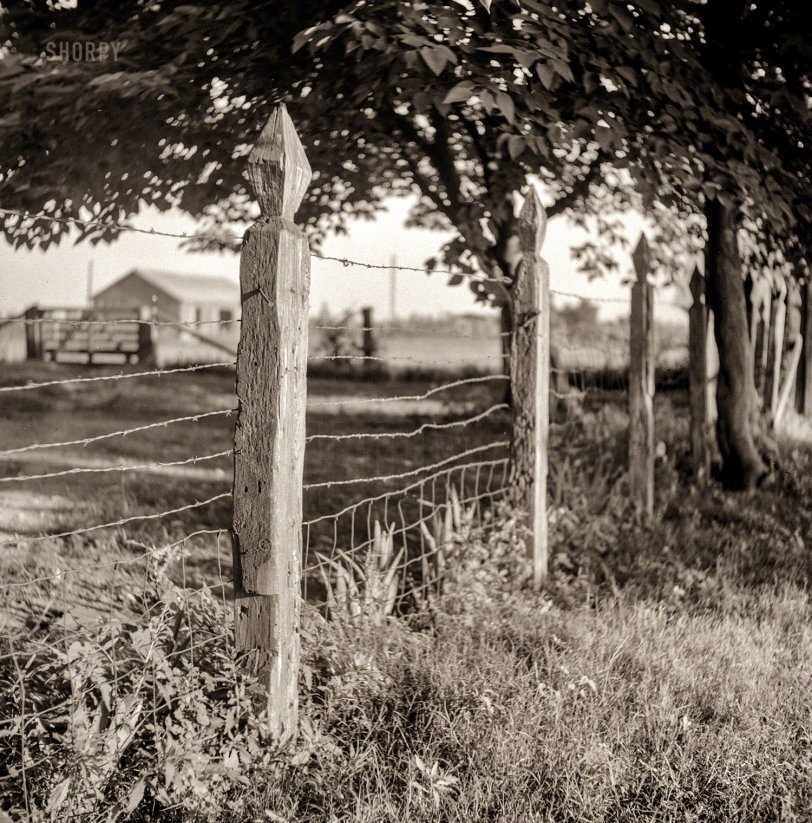


Framed or unframed, desk size to sofa size, printed by us in Arizona and Alabama since 2007. Explore now.
Shorpy is funded by you. Patreon contributors get an ad-free experience.
Learn more.

- Details, Details
- What's that building to the left of the tower?
- Coal Barges
- Bromo-Seltzer
- Inner harbor
- The Basin
- What a headache!
- Giant stepladder?
- Baldwin 62303
- Baldwin VO-1000
- Cold
- No expense spared
- Tough Guys
- Lost in Toyland
- And without gloves
- If I were a blindfolded time traveler
- Smoke Consumer Also Cooks
- Oh that stove!
- Possibly still there?
- What?!?
- $100 Reward
- Freeze Frame
- Texas Flyer wanted
- Just a Year Too Soon
- WWII -- Replacing men with women at the railroad crossing.
- Yes, Icing
- You kids drive me nuts!
- NOT An Easy Job
- I wonder
- Just add window boxes
Print Emporium
Pointed Posts: 1940

August 1940. "Fenceposts on King and Anderson Plantation, Clarksdale, Mississippi Delta, Mississippi." Medium format negative by Marion Post Wolcott for the Farm Security Administration. View full size.
On the Fence
I agree with trackes; the pointed finial was most likely to shed rain to prevent rot. Functionally that could have been achieved with a single slanted cut, but these square posts have been laboriously sawed twelve times each!
I'm wondering if they have been re-purposed. I see bent nails and orphan nail-holes in the post facing the camera and what may be a weathered notch cut into the bottom section. Maybe they came from a picket or rail fence and were later set as posts for this barbed-wire enclosure. Hogwire at the bottom and gate opposite suggest the pen's occupants were wont to nibble the greener grass on yon side or were small enough to wriggle under the bottom wire.
I hated fence mending as a youngster. I got my PhD (post hole degree) in the red East Texas clay and generally took twice as long as my seventy-something grandfather to use a wire-stretcher to set a fence.
We would leapfrog. Dig a hole, set the post, tamp it down - then go back one post and stretch and staple the four strands of wire and bring it to the new post while the other fellow moved ahead to dig the next hole, ad infinitum. There's an art to it. You didn't want to stretch the wire too tightly, lest it pull against the staples and pop them out over time. You couldn't leave it too slack, either.
Our Herefords and Brangus (cross between heat-tolerant Brahma and black Angus) would rub and nose and lean on the fences. I recall running them from one pasture to the next and watching them reach under the very fence-line they just left to eat the grass they previously stood upon to reach under the wire the other direction.
Goober Pea
Simply Amazing
that comments of one photograph have increased any knowledge of fence post that I have had in the last 71 years. Shorpy should be part of a schools curriculum!
Not just for ornamentation
The pointed tops made rain flow off and helped prevent rotting. Sometimes you would see a hole bored at a downward angle close to ground level; people would pour used motor oil in the hole so it would soak into the post and retard mold and insects from attacking the wood. Had an old book on fences and gates for farm, lost it during a move, but was well worth reading.
























On Shorpy:
Today’s Top 5